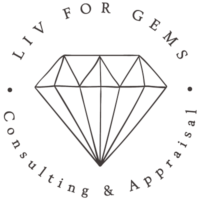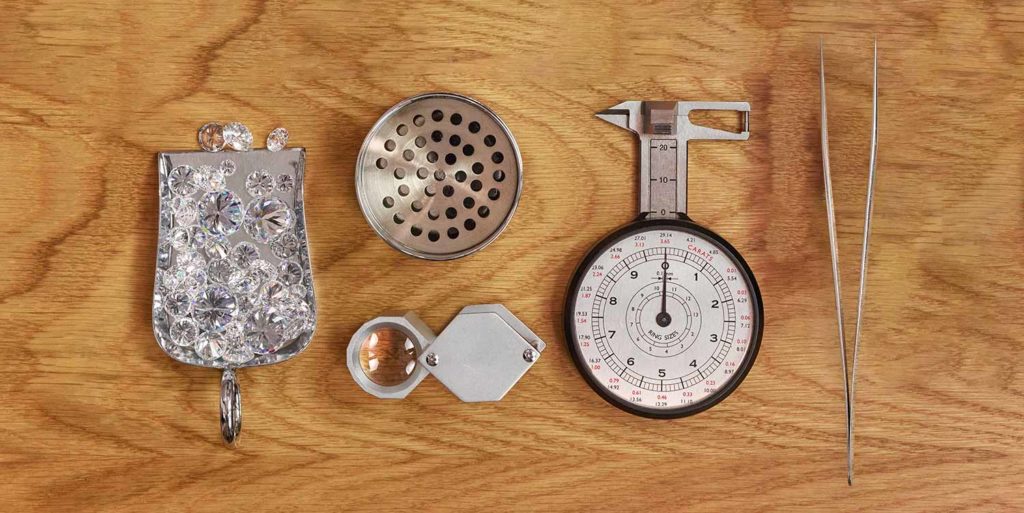Cut
How well a diamond is cut determines the amount of light that enters the stone and then returns to your eye, aka its sparkle. A diamond’s cut is graded by examining the proportions of all the facets, the girdle, the culet, and sides of the stone. Most commercially sold diamonds are cut graded Good or Very Good. Contributing to a diamond’s cut grade is the quality of its polish and symmetry, which are determined by examining how the facets are arranged.
Liv’s Tip: A round brilliant diamond graded with Excellent cut and I, J, or K color will display a dazzling show of light (dispersion) and come alive every time the wearer moves her hand. This combination of cut and color can also save the buyer hundreds or even thousands of dollars.
Color
The Gemological Institute of America grades non fancy colored diamonds on an alphabetical scale of D to about L. Most “colorless” diamonds are graded based on the amount of yellow or brown that is visible. Diamonds with more saturated color are considered Fancy colored and are graded according to another scale. Diamonds come in almost every color, thanks to trace elements mingling with carbon when the stone is formed; the most rare color is red. Color grade for colorless diamonds is determined by comparing a diamond to a master set of color graded diamonds or cubic zirconia stones.
Liv’s Tip: Diamond color is a great “C” to be flexible and open minded with. Despite what any gemologist or jeweler might say, no diamond can be reliably color graded by the naked eye without comparing it side by side with master set stones. It is faux-pas to make a determination on a color grade without comparing it with master stones. Don’t get hung up on needing an F graded stone, you most likely couldn’t tell it apart from a G or an H.
Clarity
A diamond’s clarity is defined by what is (or isn’t) inside the stone. Internal and surface characteristics usually form when the crystal structure of the diamond is formed deep in the earth’s crust, though many things can happen when a stone is cut as well. The GIA’s clarity grades are as follows: F-Flawless, IF-Internally Flawless, VVS1-Very Very Slightly Included, VVS2, VS1-Very Slightly Included, VS2, SI1-Slightly Included, SI2, I1-Included, and I2. Clarity grading is extremely subjective, there is a reason the GIA as three people clarity grade a single diamond. Two diamonds with the same clarity grade can look dramatically different, and you may like the look of a stone with a lower clarity grade better, so it’s important to look closely at each stone and not just make a decision on the grade alone.
Liv’s Tip: Jewelry salespeople will sometimes call any graded stone “eye-clean” just to make you feel alright about it, though that is extremely subjective since we all have varying eyesight. Examine every diamond closely, and under 10x magnification with a jeweler’s loupe just to compare. If a salesperson doesn’t offer you a loupe (pronounced LOOP), ask for one. If you don’t like what you see, or you want to compare with another of the same clarity grade, let them know. If a jeweler offers you an “SI3” stone, run. There is no such thing, and that stone is likely actually I1 or I2. After I1, the integrity of the stone may be questionable. I recommend going no lower than SI2 if possible.
Best- F-IF-VVS1-VVS2-VS1-VS2-SI1-SI2-I1-I2 -Worst
Carat
Diamond size is described by its weight, which is measured in carats. Some tools a gemologist may use to determine the carat weight of the stone are millimeter gauges, leverage gauges, table gauges, and carat scales. Cut plays a huge role in the carat weight of a stone, which is why I cover overly deep stones specifically in many other posts. A diamond’s price is per carat, and the larger a diamond is, the higher the per carat price is. Carat weight does not always translate to the expected face-up size of a diamond, and it’s important to always keep in mind that you are paying for how heavy a stone is, not how big it is.
Liv’s Tip: Finding a “just under” stone can be a huge hit of luck. For example: Anything heavier than 2.97 carats can be considered – and priced – as 3 carats. It’s possible for a gemologist jewelry consultant to find a 2.90 or 2.95 carat diamond that still has a large face-up size, thanks to its cut, but is priced lower per carat. These are hard to find, since it is not ideal for a gem cutter to end up with this kind of stone, but they are out there. You’re welcome!
Cost
The unofficial but most important “C” when diamond shopping is Cost. There are endless possible combinations of the previous four Cs when diamond shopping, and each combination has its own pros and cons and cost. I can help you determine which Cs are the most important to you and what to prioritize, so the money you spend goes further. That is the winning combination.

